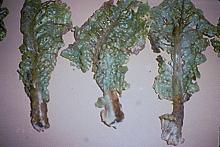Cause Microdochium panattonianum (formerly Marssonina panattoniana), a fungus that overwinters on crop refuse or in soil as microsclerotia, surviving in soil as long as 4 years. It also can be harbored in weed hosts such as prickly lettuce (Lactuca serriola). The disease is important only in prolonged periods of wet weather when it may cause heavy losses. Optimum temperatures for infection are 68°F to 72°F, but infection can occur between 50°F and 86°F. Spores are produced on foliar lesions and can spread by splashing water, Romaine and head lettuce types are more susceptible to the disease than green leaf, bibb, or red leaf types, but all lettuce varieties as well as several Lactuca weed species are affected.
Symptoms Small, circular water-soaked lesions appear first on lower leaves, enlarge to become more elliptical, and turn brown. The centers often fall out, leaving black-margined holes in the leaf (shothole). Spots progress from older leaves to inner, younger leaves. Outer leaves often break off.
Cultural control
- Reduce crop refuse. Plow and cultivate lettuce parts deeply into soil.
- Sanitation measures for greenhouses.
- Treat benches and seedling trays with a dilute bleach solution.
- Remove and destroy infected seedlings promptly.
- Sterilize soil with steam, if available.
- Practice crop rotation, ensuring that fields are out of lettuce production for 4 to 5 years.
- Avoid cultivating in wet weather.
- Prevent moving infested soil to lettuce fields by washing equipment between fields.
- If infections are few, remove affected plants and any old, dead leaves as soon as spots are visible.
- Control prickly lettuce and other weed hosts.
- Plant lettuce types that are more resistant.
Chemical control
- Copper products (Group M1) are registered but should not be used as stand alone.
- Badge SC at 0.75 to 1.5 pints/A on 5- to 10-day intervals. Preharvest interval is 0 days. 24-hr reentry for greenhouse use; 48-hr reentry for all other applications.
- Mancozeb formulations (Group M3) are labeled.
- Dithane F45 Rainshield at 1.2 to 1.6 quarts/A on 7-day intervals is labeled for other diseases of lettuce and can be used to control antracnose in Oregon . Do not apply within 7 days of harvest. Dithane F45 Rainshield at 1.5 quart/A on 7- to 10-day intervals can be used on seed crops in Washington (SLN WA-220008). 24-hr reentry.
- Roper DF Rainshield at 2 lb/A on 7- to 10-day intervals can be used on seed crops in Washington (SLN WA-1300003). 24-hr reentry.
- Rhyme (Group 3) at 5 to 7 fl oz/A. Alternate or tank-mix with a non-Group 3 fungicide for resistance management. Preharvest interval is 7 days. 12-hr reentry.
- Strobilurin fungicides (Group 11) are labeled for use. Do not make more than one (1) application of a Group 11 fungicide before alternating to a labeled fungicide with a different mode of action.
- Cabrio EG 12 to 16 oz/A on 7- to 14-day intervals. Preharvest interval is 0 days. 12-hr reentry.
- Dexter Max (Group M3 + 11) at 1.7 to 2.25 lb/A on 7- to 10-day intervals. Remove residues from head lettuce by stripping and trimming. Preharvest interval is 10 days. 24-hr reentry.
- Quadris Flowable at 6 to 15.5 fl oz/A on 7- to 14-day intervals. May be applied the day of harvest. 4-hr reentry.
- Trilogy at 0.5% to 1%. Not labeled for use in Oregon. Do not use above 90°F or when plants are under heat or moisture stress. Do not use when foliage is wet as good coverage is essential. Poor control as a stand-alone product. 4-hr reentry. O
Biological control
- Actinovate AG at 3 to 12 oz/A as a foliar spray on 7- to 14-day intervals. 4-hr reentry. O
- Actinovate Lawn & Garden at 1/2 to 1 teaspoon/gal water. H O

